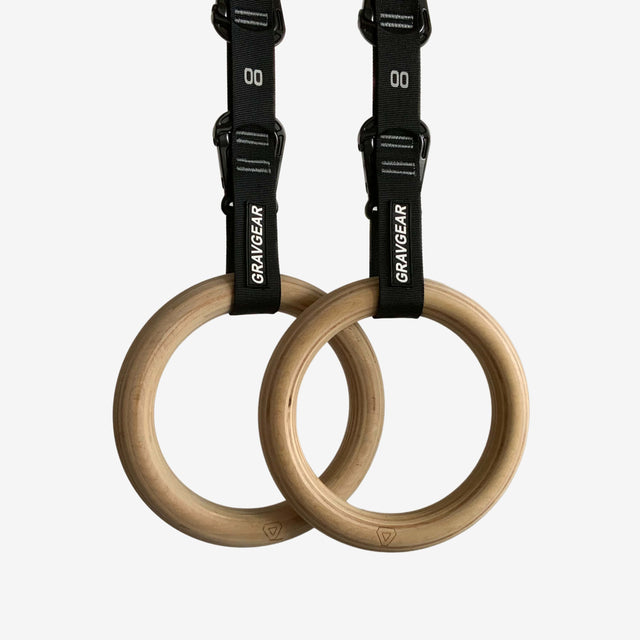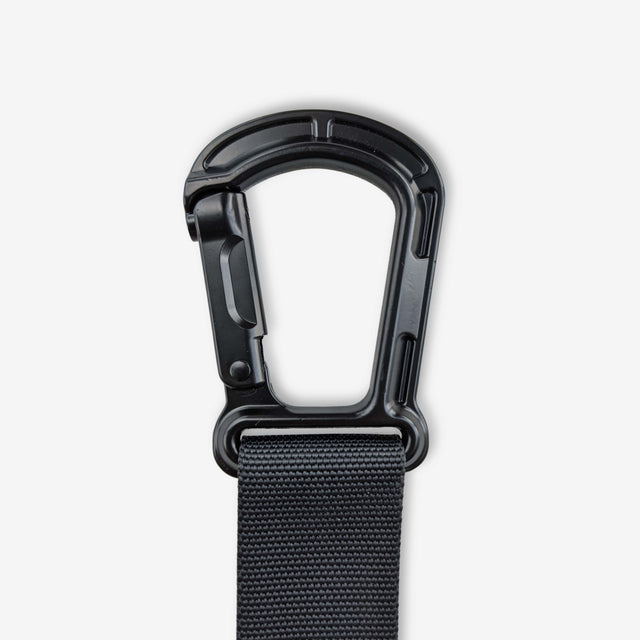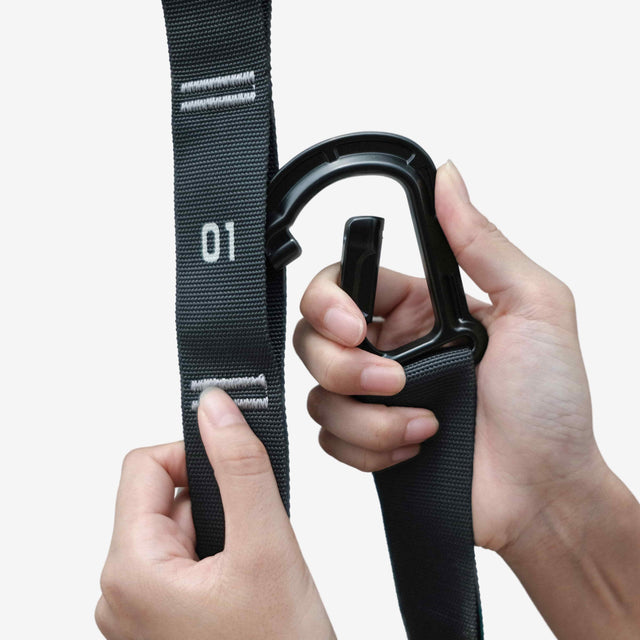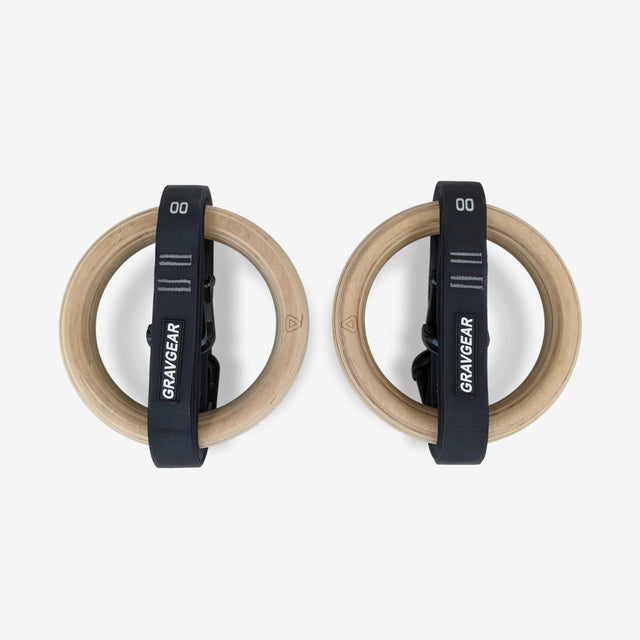How to Choose Gymnastic Rings That Olympians Would Approve
Wood rings provide the best grip for muscle-ups and advanced moves but require dry conditions. Plastic rings are durable, weatherproof, and perfect for outdoor or beginner setups. Metal rings thrive in parks but can be slippery. Use carabiner straps for fast adjustments and numbered straps for perfect alignment. Choose based on your training goals.
What we’ll cover:
- Wooden gymnastic rings vs plastic vs steel? KEY TAKEAWAYS
- Material comparison of wood, plastic, & steel gymnastic rings
- Adjustability & convenience of carabiner gymnastic rings or cam buckles
- In-depth comparison of wood vs plastic gymnastic rings (also considering metal gymnastic rings)
- Carabiner gymnastic rings & straps
- When rings with cam buckles make sense
- How strap length impacts usability
- Carabiner vs. cam buckle – what’s better?
- What buyers often miss when choosing gymnastic rings
- FAQs
Wooden gymnastic rings vs plastic vs steel? KEY TAKEAWAYS
When it comes to gymnastic rings, the devil’s in the details. Whether you’re training indoors or out in the bush, knowing what to look for will save you from frustration and wasted cash.
Wooden gymnastic rings
Best for advanced grip, stability during progression exercises, and dry training setups. If you’re aiming to nail muscle-ups or static holds, these are your go-to.
Plastic gymnastic rings
Durable and weatherproof, making them ideal for outdoor setups or humid conditions. Budget-friendly for beginners dipping their toes into bodyweight training.
Metal gymnastic rings
Bombproof durability for public parks or permanent outdoor rigs. Great for setups where theft or extreme weather is a concern.
Material comparison of wood, plastic, & steel gymnastic rings
The material of your rings sets the tone for your entire workout. It impacts grip, comfort, and longevity in ways you might not expect. If grip is your top priority, wood wins every time. For outdoor setups that can take a beating, plastic rings are the safe bet.
Wooden gymnastic rings
Top of the heap for grip and control.
Wood absorbs sweat, giving you buttery smooth stability for muscle-ups and false grips. This is why Olympians swear by it.
But wood doesn’t love rain or the Aussie sun, so keep them indoors or under cover.
If you’re aiming for precision and progression, wood is your mate.
Plastic gymnastic rings
The bombproof option for outdoor warriors.
Waterproof and rugged, plastic rings can handle everything from morning dew to torrential rain.
They lack the tacky grip of wood, but textured plastic and chalk can bridge the gap.
Perfect for the backyard or shady park setups.
Metal gymnastic rings
Indestructible and solid as nails, metal rings are your go-to for permanent outdoor rigs.
But there’s a trade-off: they get cold in winter, slippery when wet, and they’ll cost you a pretty penny. Great for calisthenics parks, not so much for your home gym.
Adjustability & convenience of carabiner gymnastic rings or cam buckles
Gymnastic rings are only as good as the straps and hardware they come with. Shoddy buckles or unmarked straps can turn your workout into a nightmare.
Carabiner gymnastic rings vs cam buckles
Carabiners
Quick and versatile. Perfect if you’re switching up exercises on the fly or adjusting height mid-session. They’re a game-changer for supersets and multi-user setups.
Cam buckles
Reliable and snug. They’ll keep your rings steady but can be a bit finicky if you’re adjusting often.
Numbered straps
Markings on straps are a lifesaver. They ensure both rings are perfectly aligned, sparing you from frustrating micro-adjustments.
Whether you’re doing dips or pull-ups, alignment keeps you strong and stable.
Strap length & build
Longer straps mean more versatility. Hang them from a tree, a ceiling joist, or even a swingset.
Look for heavy-duty materials with reinforced stitching. Your life literally depends on it.
Why these features matter
- The right hardware makes your rings feel like an extension of your body.
- Misaligned or slippery setups can mess with your form and your progress.
- A few extra bucks on quality gear is always worth it.
Be sure to choose the material and features that match your goals and where you train.
Up next, we’ll dig into the battle of grip and durability between wood and plastic rings.
In-depth comparison of wood vs plastic gymnastic rings (also considering metal gymnastic rings)
When it comes to choosing between wooden and plastic gymnastic rings, your priorities (grip, durability, or versatility) will shape your decision.
Let’s dive into the details so you can make the best choice for your training style and environment.
Wooden gymnastic rings
Wooden rings are the gold standard for serious athletes. Their unmatched grip and comfort make them ideal for progression-based exercises and high-skill movements.
Sweat absorption & grip
Wood absorbs sweat like a sponge, providing a secure grip that plastic can’t rival.
Whether you’re pushing through muscle-ups or mastering levers, wooden rings keep your hands where they need to be, no matter how long the session.
Note that wooden rings are ideal for muscle-ups because their texture locks in your false grip, even when fatigue kicks in.
Comfort & blister prevention
Wood’s natural texture minimizes hand movement during exercises, reducing the chance of calluses or blisters.
This means less time worrying about your hands and more time focusing on your form.
Olympic-level endorsement
There’s a reason Olympians exclusively use wooden rings—they deliver peak performance for the toughest routines.
The secure grip allows athletes to push harder, especially during transitions that require precise control.
Limitations
Wooden rings shine indoors or in sheltered setups but don’t fare well against harsh weather. Rain and humidity can degrade their durability over time, making proper storage a must if you’re training outdoors.
Plastic gymnastic rings
Plastic rings are the workhorses of the outdoor calisthenics world. Durable and weatherproof, they’re built for setups in unpredictable environments.
Weather resistance & durability
Plastic rings are designed to handle rain, humidity, and sun exposure without breaking a sweat.
They won’t warp or degrade if left hanging from a tree or outdoor frame outside.
Grip under pressure
Plastic’s smooth surface is manageable with chalk or textured finishes but can feel slippery when wet or sweaty.
This makes them a solid choice for less grip-intensive exercises like rows and push-ups but less ideal for advanced moves like muscle-ups.
Affordability & versatility
As a budget-friendly option, plastic rings are great for beginners testing the waters of ring training or for outdoor enthusiasts who don’t want to worry about wear and tear.
Limitations
The lack of natural tackiness means grip can be an issue for advanced calisthenics, especially during sweaty sessions. You’ll need chalk or tape to bridge the gap.
When to choose wooden gymnastic rings over plastic
Choose wooden rings if you’re chasing precise, skill-focused progressions.
Opt for plastic if you want bombproof gear for rain-or-shine outdoor workouts.
Do you need precision or durability?
- If grip and control are your top priorities for high-skill exercises like dips and false-grip pull-ups, wood wins every time.
- For outdoor setups, humid climates, or beginner routines, plastic’s durability and weatherproof build make it the clear choice.
Exploring the option of metal gymnastic rings
Heavyweight feel & exercise flow
Metal gymnastic rings have a distinct heft to them that some athletes appreciate.
The added weight provides a more stable feel during certain moves, like dips and support holds, where the rings’ solid presence can help with balance.
However, this heft doesn’t improve the difficulty or effectiveness of exercises and, for many, it’s a neutral factor rather than a game-changer.
Durability built for the outdoors
Metal rings are virtually indestructible. If you’re setting up in a public park or building a permanent outdoor calisthenics setup, metal is a solid option.
They can handle all the elements—rain, snow, blazing sun—and won’t crack, warp, or degrade.
For spaces where theft or vandalism might be a concern, metal rings are a practical choice.
As one reviewer of steel gymnastic rings put it, “They’re bombproof, perfect for my park setup where gear needs to stay locked and loaded 24/7.”
The downside?
Metal rings aren’t without their flaws.
The smooth surface often becomes slippery when wet or sweaty, requiring chalk or grip tape just to maintain control during muscle-ups or false grip holds.
The material also conducts cold like a dream—great if you’re storing ice cream, not so much if you’re training in cooler climates.
Add to that the clanging noise they make when bumped together, and the appeal quickly fades for indoor or casual home use.
When & where to choose metal rings
Metal rings excel in shared spaces like public parks or calisthenics hubs, where theft resistance and long-term durability are key.
But for home gyms or athletes prioritizing comfort, wood or textured plastic wins.
As one athlete said, “Metal rings felt indestructible, but they were just too cold and slippery for my garage gym.”
Metal rings thrive outdoors. If you’re leaving gear exposed to weather or want a low-maintenance option for high-traffic spaces, they’re your best bet.
For anything else, the comfort and versatility of wood or plastic are hard to beat.
Carabiner gymnastic rings & straps
How to set up with carabiners
1️⃣ Choose a stable anchor point
Find something sturdy like a pull-up bar, tree branch, or garage beam that can support your bodyweight without shifting.
2️⃣ Loop straps through carabiners & rings
Thread the straps through the gymnastic rings, secure them with carabiners, and lock them into place.
3️⃣ Adjust heights using numbered markings
Use the numbered markings on the straps to ensure both rings are level.
Quick tweaks can be made for exercises like dips, pull-ups, or push-ups.
Why carabiner gymnastic rings are a game-changer
Carabiners streamline adjustments like nothing else. Whether you’re moving from pull-ups to push-ups or swapping out for a taller workout partner, you can tweak strap lengths in seconds.
This is a huge plus if your workouts include supersets or involve frequent exercise variations.
For outdoor setups where you’re constantly re-anchoring, they make teardown and setup fast and hassle-free.
When rings with cam buckles make sense
Cam buckles are ideal if you’re not adjusting strap lengths often. They lock straps into place firmly, which is useful for permanent setups or single-exercise sessions.
The downside? They’re slower to adjust and can be a pain if you’re switching heights multiple times mid-workout.
How strap length impacts usability
Strap length dictates how versatile your setup is. Longer straps let you train at various heights, from low for push-ups to overhead for pull-ups and levers.
If you’re taller or using higher anchor points (like trees), go for longer straps—usually around 15 feet.
Numbered markings make it easy to align both sides for even exercises.
Carabiner vs. cam buckle – what’s better?
Go for carabiners if your workouts involve a mix of exercises or partners.
For static setups, cam buckles offer better locking strength without the need for constant fiddling.
Choose straps with clear numbering to eliminate guesswork and keep your alignment spot-on.
| Feature | Carabiner Straps | Cam Buckle Straps |
| Adjustment speed | Quick and easy | Slower, requires more effort |
| Best use case | Dynamic workouts with frequent changes | Permanent or single-height setups |
| Ease of alignment | Numbered straps simplify matching heights | Requires manual measuring |
| Durability | Durable but may wear with extreme outdoor exposure | Reliable and rugged |
What buyers often miss when choosing gymnastic rings
The 2 hidden details that actually matter
When you’re shopping for gymnastic rings, it’s easy to get distracted by price or flashy marketing.
But here’s the deal: overlooking the finer details can leave you with a set that’s frustrating to use—or worse, unsafe.
🥇 Material quality
Rings made from cheap materials (plastic that feels brittle or wood with splinter-prone finishes) might save you a few bucks upfront but won’t hold up when it counts.
For advanced moves like dips or muscle-ups, you need rings that feel rock-solid under your grip.
🥈 Strap markings
Straps without numbered markings make consistent setups nearly impossible.
Over time, uneven straps can create subtle imbalances, leading to one side always working harder than the other.
You’ll feel it in your shoulders—trust me.
Skimping on quality straps can compromise safety during advanced moves like muscle-ups or dips.
Look for bombproof straps that lock into place under tension.
Also, numbered straps not only save time but also prevent uneven setups that can lead to muscle imbalances, keeping your form consistent across workouts.
Identifying reliable brands
Not all gymnastic rings are created equal, and this is where user reviews become your best friend.
Look for brands with a reputation for durability and safety.
What to watch for in reviews
Check if users mention splinters (wood rings), slippage (straps), or issues with the buckles or carabiners failing under weight.
Be sure to steer clear of rings where multiple reviews mention needing to sand or repair them out of the box.
AAA gear vs. duds
If the straps or buckles feel flimsy or the rings seem too lightweight, you’re dealing with gear that won’t last.
A solid set of rings should feel premium, whether they’re wood, plastic, or metal.
How to avoid buyer’s remorse 😵💫
Think long-term. Are you planning to train outdoors or indoors? Are you a beginner working on body rows or an advanced athlete nailing strict muscle-ups?
Match the material, strap system, and durability to your goals—not just the price tag. It’s the difference between a tool you’ll love using and one you’ll ditch in frustration.
For gymnastic rings, it’s all in the details. Don’t overlook the small things—they make the biggest difference. As when you train on them as often as you do, small things add up.
FAQs
What thickness works best for gymnastic rings?
Choose 1.1-inch (28mm) if you’re smashing pull-ups or muscle-ups. Go for 1.25-inch (32mm) for dips and push-ups—it spreads the weight better and feels more natural in your hands.
Can wooden rings handle outdoor training?
Not really. Wooden rings don’t play well with rain, humidity, or harsh sun. If you’re heading outdoors, grab some plastic rings instead—they’ll last and won’t warp.
What strap system adjusts fastest?
Carabiners are your mate here. They’re quick, easy, and ideal if you’re constantly tweaking height for different exercises. Cam buckles are solid too, but slower and better for setups that don’t move much.
What’s the biggest difference between wood and plastic gymnastic rings?
Wood gives unbeatable grip and comfort, even when you’re dripping sweat, which makes it perfect for high-skill moves like false grips. Plastic, on the other hand, thrives outdoors—it’s durable, weatherproof, and beginner-friendly.
When should I pick wood over plastic rings?
If grip, control, and advanced exercises are your focus, go for wood. If you’re training outside or need something weatherproof and hassle-free, plastic is the way to go.
Are carabiner gymnastic rings worth it?
Absolutely. They’re a game-changer for saving time mid-workout, especially when adjusting for dips, pull-ups, or push-ups. Quick, precise, and no mucking about.
What’s the deal with gymnastic rings that have carabiner straps?
Carabiner straps let you adjust height in seconds, keep alignment perfect with numbered straps, and stop slipping. If convenience matters, they’re the upgrade to go for.
Should I pick carabiner straps or cam buckles?
Carabiner straps are best if you’re constantly changing exercises or sharing your setup. Cam buckles work better for permanent or single-height setups—they hold tight and don’t budge.
Are metal gymnastic rings better than wood or plastic?
Metal rings are bombproof for outdoor rigs and public parks—indestructible, theft-proof, and weatherproof. But they’re cold, slippery, and uncomfortable compared to wood or plastic. Use them if durability trumps comfort.
Why do pros stick to wooden rings?
Grip. Wooden rings deliver that premium feel and control that high-skill athletes rely on. That’s why Olympians don’t mess with plastic or metal when it comes to competition.
How do I choose the right gymnastic rings for me?
Think about where and how you’ll train. Wooden rings for grip and progression, plastic for outdoor durability, and metal for public or permanent setups.
Why are carabiner straps considered premium?
They save time and keep alignment perfect. No endless fiddling with straps—just set them up and go. Ideal for dynamic workouts and anyone who hates a crooked setup.
Are steel gymnastic rings a good buy?
Only if you’re setting up a permanent outdoor rig. They’ll handle anything the elements throw at them, but they’re heavy, slippery, and freezing in cold weather—not exactly beginner-friendly.
That’s all folks!
Choose gymnastic rings that align with your goals and environment.
Whether it’s perfecting a false grip or finding rings that can withstand outdoor elements, the right set makes all the difference.
So, if you found this helpful:
- Comment below with your ideas about this blog (improvements, questions, your own personal experience)
- Hop in the 3k+ member Gravgear telegram channel and get to know who we are and connect with other people like you
- Send the link to this blog to any calisthenics group chats you’re in and share the insights










0 Comments
There are no comments for this article. Be the first one to leave a message!